Do you pay the most attention to your Fitbit, Apple Watch, Garmin, or another wearable’s step count and total calories burned? Do you only review the miles or laps you ran, cycled, or swam?
If that’s all you notice on your wearable, you’re missing out on one of the most important metrics available, the VO2max score (also called cardio fitness score.)
This overlooked measurement is likely one of the most powerful predictors of your current health and fitness.
Monitoring your VO2 Max (cardio fitness level) over time is a great way to see if you are getting fitter or going in the opposite direction and losing your fitness.
Contents
- 1 Why your VO2max or cardio fitness score matters
- 2 What is the score range for cardio fitness and VO2 Max?
- 3 How do fitness trackers measure VO2 max scores?
- 4 Calculating VO2max from heart rate data on fitness trackers & smartwatches
- 5 Are VO2 Max calculations accurate on fitness trackers?
- 6 Why are my VO2 max readings missing on Apple Health?
- 7 Why is my VO2 Max score on my fitness tracker so low?
- 8
- 8.1 How to compare your V02 Max on Apple Watch for similar age and sex
- 8.2 How does Apple Watch determine a low or high Cardio Fitness score?
- 8.3 How accurate is Apple Watch’s Cardio Fitness Score?
- 8.4 What causes inaccurate cardio fitness scores on Apple Watch?
- 8.5 Cardio Fitness Score not showing on Apple Watch
- 8.6 The 5.75 Minutes mystery for Apple Watch users
- 8.7 Software updates on the fitness tracker
- 8.8 Wrong user profile information
- 8.9 Check the heart rate sensor on the back of the fitness tracker
- 8.10 Check with your doctor and get a real VO2 Max test.
- 9 Can you increase your VO2 max score on your Fitness tracker?
Related articles
- Is your Apple Watch Cardio Fitness (VO2 Max) not showing any data? Let’s fix it
- Cardio Fitness levels feature on Apple Watch. Here’s what you should know
- Train smarter for aerobic fitness: FatMaxxer vs. Runalyze
- Tips for using Garmin to monitor your health this year
- Cardio Fitness Levels on Fitbit: The Ultimate Guide
Why your VO2max or cardio fitness score matters 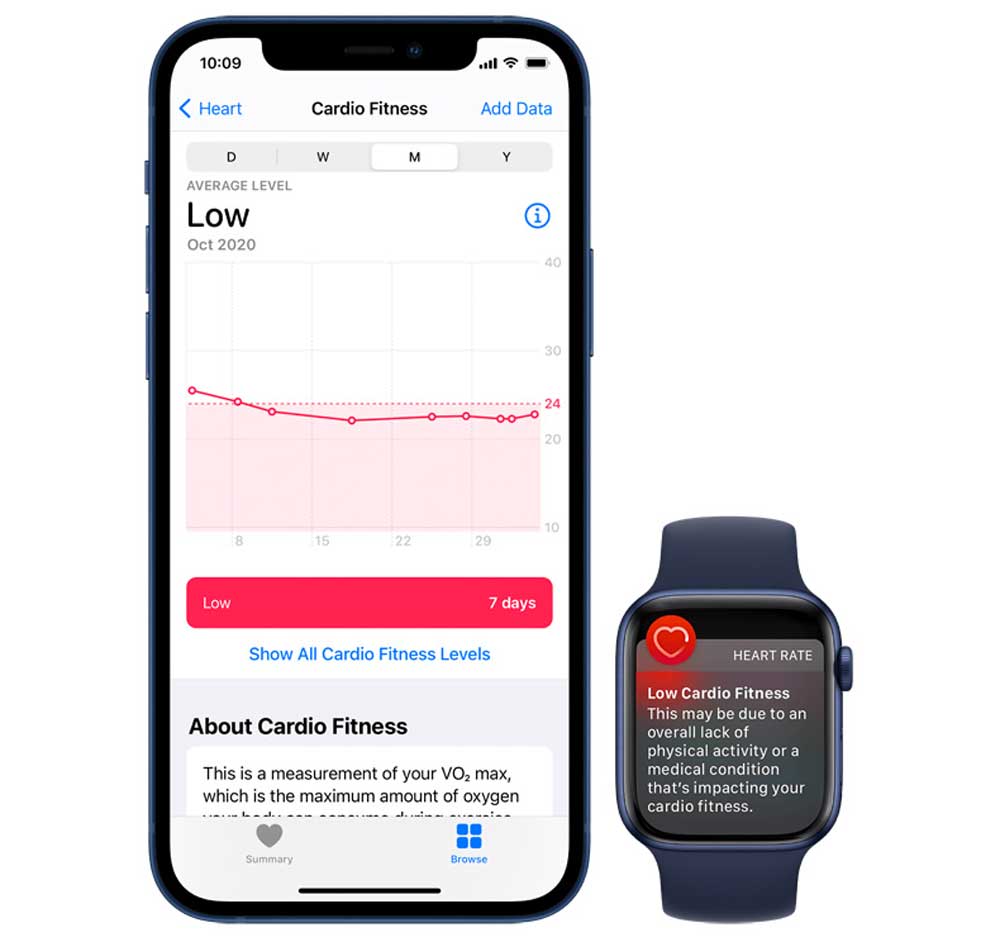
More and more wearables adopt health metrics like cardio fitness or VO2 max scores into their workout and health apps.
Unfortunately, many people have no idea what VO2 is and why it matters.
So, let’s break it down!
In layman’s terms, your VO2 Max is a strong indicator of your overall cardiorespiratory fitness (cardio fitness, for short) because it shows how well your body uses oxygen during exercise.
VO2 Max stands for: V (volume) + O2 (oxygen) + Max (maximum)
It measures the maximum amount of oxygen your body can use when exercising or engaging in any form of physical and aerobic activity.
The higher your VO2 Max, the better your cardio fitness. That means your body uptakes oxygen efficiently, and you can easily run, cycle, or exercise intensely.
Conversely, the lower your VO2 Max, the worse your cardio fitness. That means your body cannot take in and use oxygen very efficiently, so exercising strenuously is difficult.
What is VO2 Max or cardio fitness score?
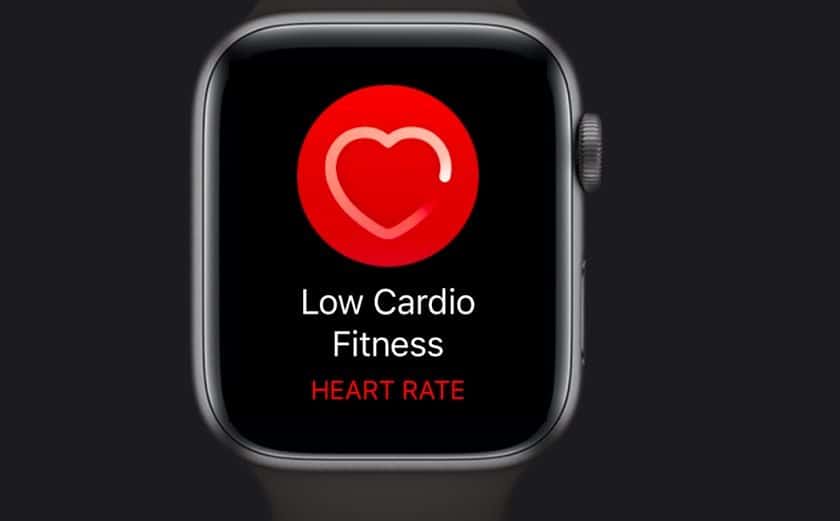
Wearables like Fitbit and Apple Watch use VO2max and cardio fitness interchangeably.
So you might see this scoring system listed as VO2 Max on one device and cardio fitness on another–they are the same!
The aerobic capacity test (VO2max), also known as the maximum oxygen consumption test, measures the maximum amount of oxygen a person (usually an athlete) can use during intense activity levels.
It is a good gauge of cardiovascular fitness and aerobic endurance levels.
In other words, VO2 Max is the maximum amount of oxygen your body can use while exercising as hard as you can.
A higher VO2 max indicates a higher level of cardiovascular fitness and endurance.
The belief is that a higher VO2 max allows one to produce more energy, thereby performing more work.
This has made the VO2 max metric the “gold standard” measure of overall fitness for endurance trainers.
Because endurance athletes have trained their bodies to use oxygen more efficiently, more oxygen circulates to their muscles, allowing them to work faster and harder.
As a result, they generally have a higher VO2 max than the average person.
What factors influence a person’s VO2 max score?
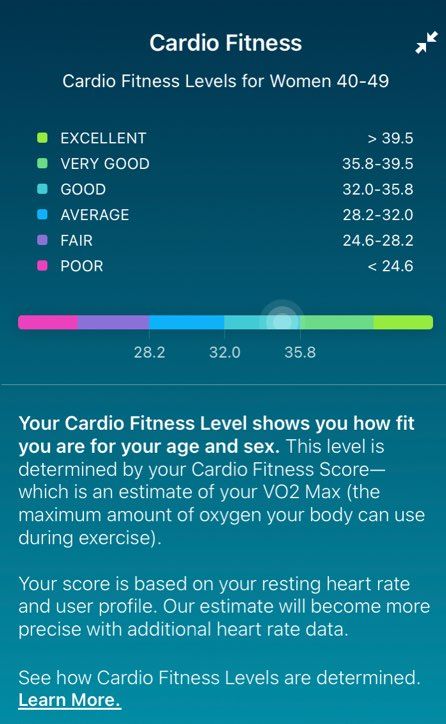
Many factors can influence VO2 max, e.g., heredity, training, age, gender, and body composition.
Structurally speaking, there are three components to the VO2 Max Puzzle.
- How much oxygenated blood your heart can pump.
- How much of it reaches your muscles.
- And finally, how much of it is utilized by your muscles.
Also important are a person’s lung capacity and heart volume.
- The greater your lung capacity, the more oxygenated blood your heart can pump, and thus your higher VO2 number
- The more oxygenated blood that can reach your muscles, the higher your VO2 max score, suggesting that capillary delivery is an essential component
- The better your muscles are at utilizing oxygen from your blood, the better your VO2 max reading
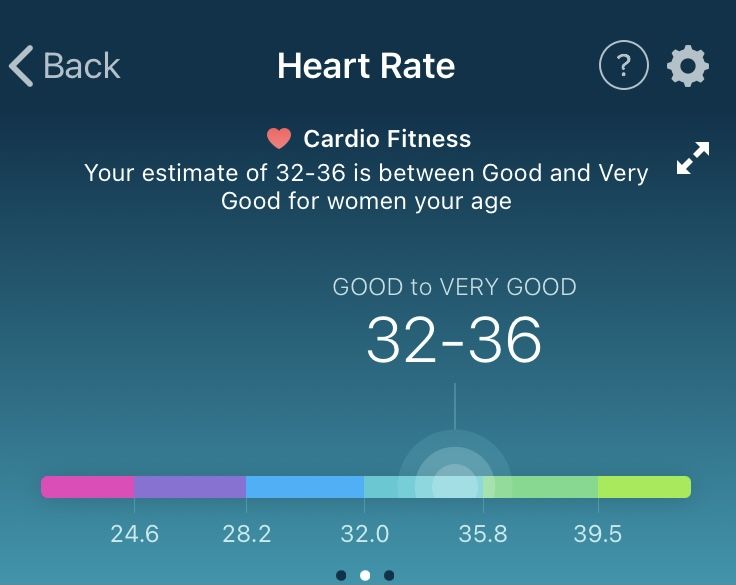
Generally, VO2 max declines with age (about 2% per year after age 30), and males typically have a greater oxygen consumption value than females.
What is the score range for cardio fitness and VO2 Max?
The average VO2 Max or cardio fitness score for untrained healthy men is around 37.9; for untrained healthy women, the VO2 Max is 27.6 across all age groups.
(2). The study’s VO2 max results were based on adults’ CPX (cardiopulmonary exercise testing).
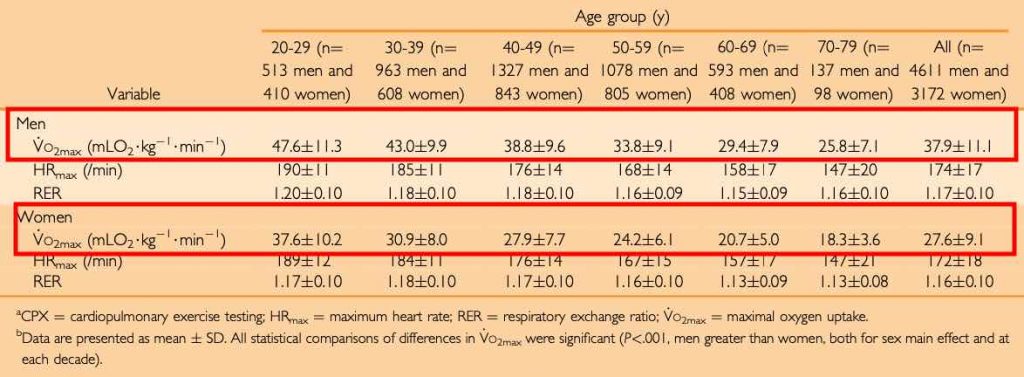
VO2 Max Norms for Men
| Age | Very Poor | Poor | Fair | Good | Excellent | Superior |
| 13-19 | Under 35.0 | 35.0-38.3 | 38.4-45.1 | 45.2-50.9 | 51.0-55.9 | Over 55.9 |
| 20-29 | Under 33.0 | 33.0-36.4 | 36.5-42.4 | 42.5-46.4 | 46.5-52.4 | Over 52.4 |
| 30-39 | Under 31.5 | 31.5-35.4 | 35.5-40.9 | 41.0-44.9 | 45.0-49.4 | Over 49.4 |
| 40-49 | Under 30.2 | 30.2-33.5 | 33.6-38.9 | 39.0-43.7 | 43.8-48.0 | Over 48.0 |
| 50-59 | Under 26.1 | 26.1-30.9 | 31.0-35.7 | 35.8-40.9 | 41.0-45.3 | Over 45.3 |
| 60 | Under 20.5 | 20.5-26.0 | 26.1-32.2 | 32.3-36.4 | 36.5-44.2 | Over 44.2 |
VO2 Max Norms for Women |
||||||
| Age | Very Poor | Poor | Fair | Good | Excellent | Superior |
| 13-19 | Under 25.0 | 25.0-30.9 | 31.0-34.9 | 35.0-38.9 | 39.0-41.9 | Over 41.9 |
| 20-29 | Under 23.6 | 23.6-28.9 | 29.0-32.9 | 33.0-36.9 | 37.0-41.0 | Over 41.0 |
| 30-39 | Under 22.8 | 22.8-26.9 | 27.0-31.4 | 31.5-35.6 | 35.7-40.0 | Over 40.0 |
| 40-49 | Under 21.0 | 21.0-24.4 | 24.5-28.9 | 29.0-32.8 | 32.9-36.9 | Over 36.9 |
| 50-59 | Under 20.2 | 20.2-22.7 | 22.8-26.9 | 27.0-31.4 | 31.5-35.7 | Over 35.7 |
| 60 | Under 17.5 | 17.5-20.1 | 20.2-24.4 | 24.5-30.2 | 30.3-31.4 | Over 31.4 |
Now, compare these average numbers with world-class elite athletes, and you see a dramatic difference.
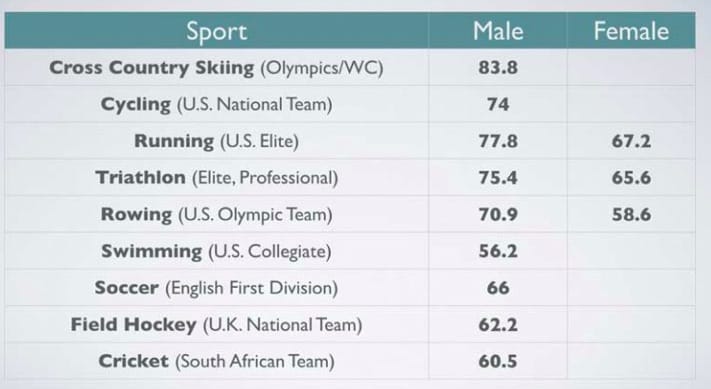
Now that we have covered some of the basics around VO2 max scores, let’s see how some of today’s wearable fitness trackers monitor cardio fitness using VO2 Max.
How do fitness trackers measure VO2 max scores?
Most fitness trackers and wearables in the market today use the optical heart rate sensor(s) to measure heart rate data and calculate your VO2 max score. This process is also known as photoplethysmography. 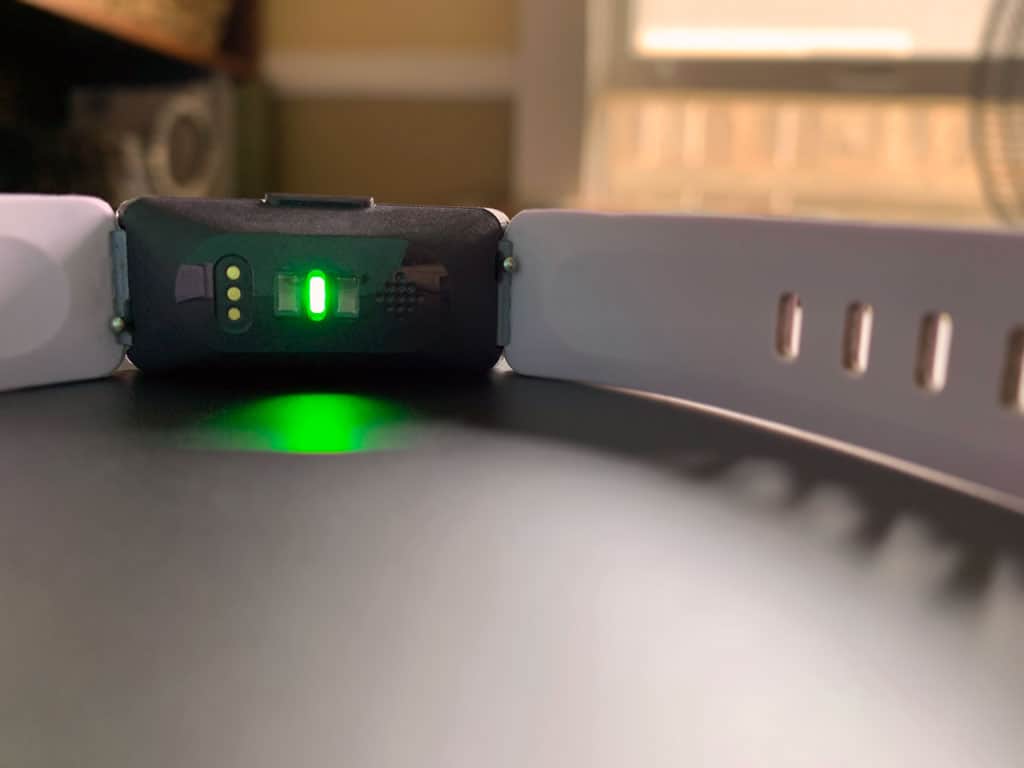 The accuracy of the VO2max function on a fitness tracker or smartwatch is a product of how good the optical heart rate sensor is on the unit, along with how the tracker calculates VO2max.
The accuracy of the VO2max function on a fitness tracker or smartwatch is a product of how good the optical heart rate sensor is on the unit, along with how the tracker calculates VO2max.
Garmin Optical Heart Rate Sensors
Fitness trackers such as Garmin smartwatches emit green light through the skin at the user’s wrist and then use a photodiode to detect changes in reflectivity that can be used to calculate heart rate. 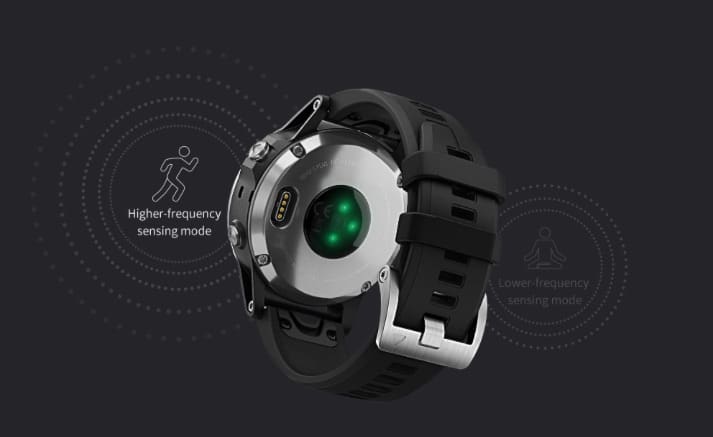
The arteries’ blood flow rate varies with the heart’s contraction (systole) and relaxation (diastole) in a periodic pattern.
During contraction, the density of hemoglobin increases, and blood absorbs more green light.
During relaxation, the density of hemoglobin is lower, and blood reflects more green light.
Apple Watch Heart Rate Sensors
Apple Watch uses green LED lights paired with light-sensitive photodiodes to detect the amount of blood flowing through your wrist at any moment.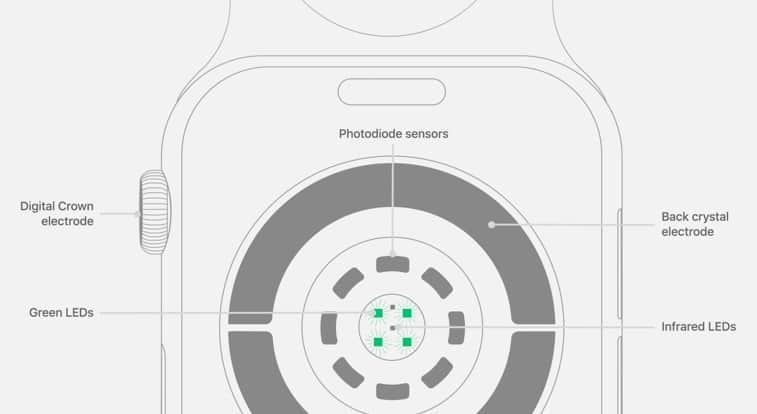
The optical heart sensor can also use infrared light.
This mode is what the Apple Watch uses to measure your heart rate in the background and for heart rate notifications.
Apple Watch uses green LED lights to measure your heart rate during workouts and breathing sessions and calculate walking average and Heart Rate Variability (HRV). 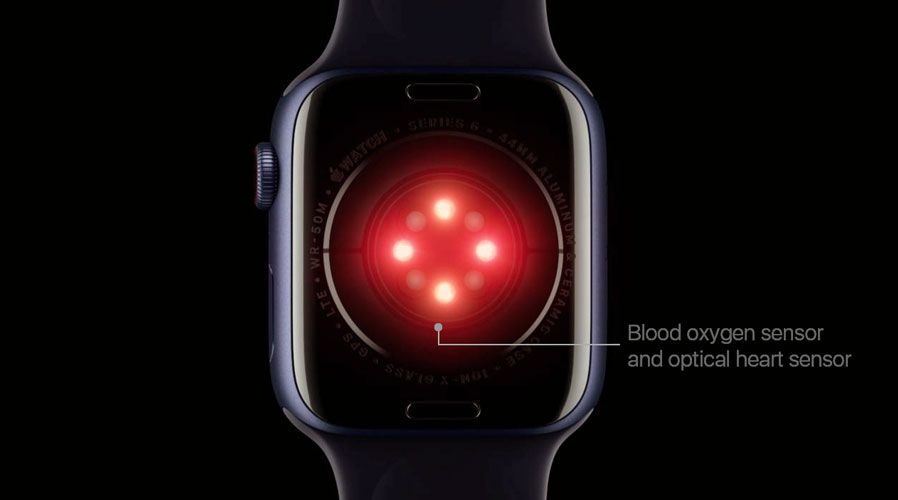
Apple Watch Series 4 or later also has built-in electrodes in the Digital Crown and the back of the Apple Watch, measuring the electrical signals across your heart when used with the Heart Rate app or the ECG app.
When you place your finger on the Digital Crown, it creates a closed circuit between your heart and arms, capturing the electrical impulses across your chest.
Apple Watch measures heart rate between 30 – 210 bpm (beats per minute).
Fitbit and other budget trackers
The Fitbit optical heart rate sensors function similarly, using LED green light and multicolor photodiodes. Fitbit can measure heart rate between 30 – 220 bpm.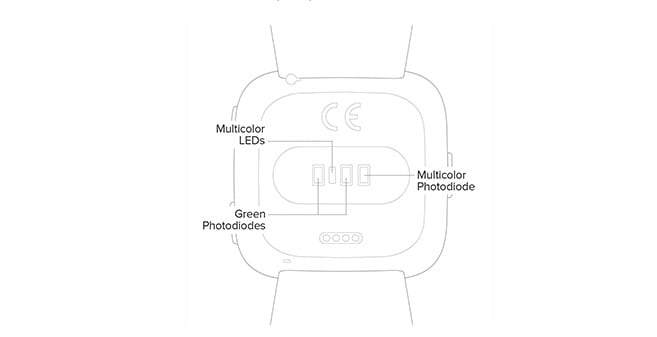
Budget Fitness trackers like MorePro or LetsCom use Nordic 52832 as the main CPU and optical heart rate sensors, such as Silicon Labs Si1142 or the PD70-01C-TR7 sensor.
These sensors usually have a single green LED to provide low-power dynamic heart rate monitoring instead of the advanced sensor collections in Apple Watch, Garmin, or Fitbit.
Once the optical heart rate sensors on your smartwatch or fitness tracker have calculated the heart rate data, they can then use various calculations to compute the VO2 max score.
Calculating VO2max from heart rate data on fitness trackers & smartwatches
You can manually calculate your VO2 Max using a standardized formula once you know your maximum and resting heart rates from the heart rate data.
Calculate VO2 Max using your resting heart rate and age:
- VO2 max = 15.3 x (MHR/RHR)
- MHR = Maximum heart rate (beats/minute) calculated using age = 208 – (0.7 x age)
- RHR = Resting heart rate (beats/minute) = number of heart beats in 20 seconds x 3
Other calculations help with the estimated VO2 Max. You can read up on them on this page from Wikipedia.
Although the algorithms used by Fitness trackers use similar computations, they look at many other factors to improve the accuracy of VO2 max calculation.
For instance, FirstBeat Analytics, used by Garmin, calculates VO2 Max based on the type of activity (running, walking speed), time spent waiting for traffic lights to turn, etc.)
Garmin VO2 Max Calculation 
In the case of Garmin, its devices leverage FirstBeat Analytics algorithms to do this. They use a proprietary calculation to determine the VO2 max score.
The algorithm behind Firstbeat Analytics’ VO2max calculation learns from you over time. The more you use your device, the more reliable your VO2 max estimate becomes.
It is also specifically designed to recognize the best data to calculate automatically. This means that stops and starts are excluded, along with any other interference that occurs along the way.
Apple Watch VO2 Max calculation 
The cardio fitness (VO2 max scores) is not visible directly on the watch in the Apple Watch case. It can be found using the Health App on your iPhone in the Respiratory section.
The calculation uses Heart rate data and your pace to calculate VO2 max. This is supposed to be an estimate.
Since the basic component used in VO2 Max calculation by fitness trackers is your heart rate data, you must understand the limitations.
Your heart rate data can differ depending upon the type of motion during which it is calculated.
If you are interested in how Apple Watch calculates VO2 Max, you will find the details in this Apple Patent document fascinating.
Motion can affect the heart rate sensor. Rhythmic movements like running or cycling give better results than irregular movements like tennis or boxing.
Fitbit Trackers VO2 max calculation 
Fitbit trackers similarly compute an estimated VO2 Max and term it as ‘Cardio Fitness Score.’
In the case of Fitbit, they calculate the VO2 Max using your resting heart rate (RHR) and your user profile.
Some of these calculations derived from base optical heart rate sensor data can be complex. For example, look at how Whoop calculates Heart Rate Variability (HRV) below in simple terms.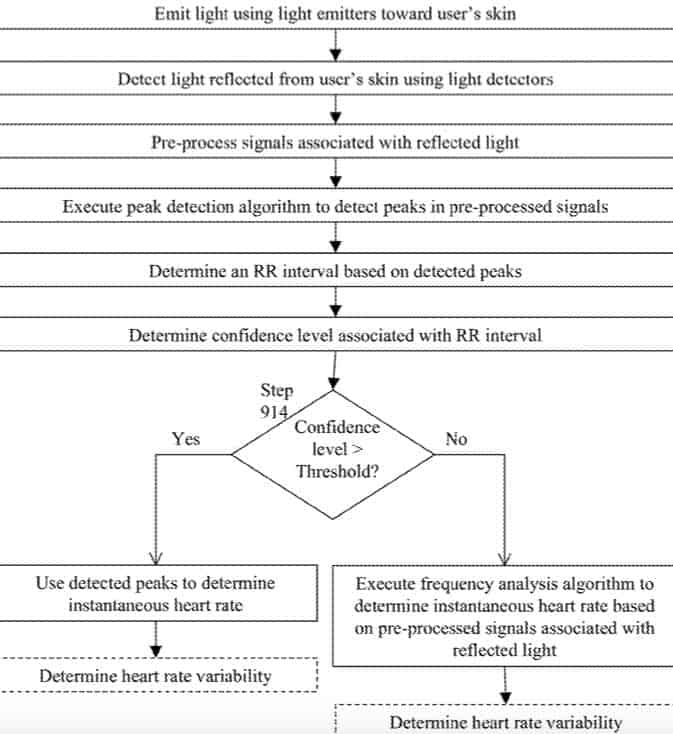
Even assumptions around Heart rate data can vary from one fitness device or fitness app maker to another.
For example, users who use the Strava app with Whoop noticed different heart rate readings.
Here is the answer from Whoop on how it treats heart rate data from Strava:
My max and average heart rates differ in Strava and WHOOP – why?
While the underlying heart rate date used for both is the same, Strava does some additional processing that can generate slight differences.
In particular, Strava will filter out GPS and associated HR data for times when you’re not moving, resulting in different average and max heart rates than shown in WHOOP.
So, the way various fitness trackers and apps compute max heart rate data can be different, resulting in variability of VO2 max readings.
Are VO2 Max calculations accurate on fitness trackers?
The relationship between heart rate and VO2 Max is not precise and varies from one individual to another.
For example, it depends upon factors when the heart rate was measured. And it’s also dependent on whether you were moving or stationary when making the VO2 max calculation.
So Apple’s predicted VO2 max, or for that matter, Garmin’s or any other fitness tracker, may not be very accurate.
Research has shown that Fitbit and other wearable trackers have accuracy issues when measuring heart rate and related metrics for darker skin tones.![]()
Some budget fitness trackers have only added SpO2 functionality as more of a marketing ploy.
Without any research-based trials or transparency around their SpO2 estimation process, these trackers use ‘Spo2’ as a marketing gimmick.
Unlike the measurements you get at a doctor’s office by wearing a face mask and running or walking on a treadmill (Cardiopulmonary exercise testing), the estimate on fitness trackers is squarely dependent upon your Apple Watch’s heart rate sensor, your pace during your workout activity and profile.
And while that’s pretty good, it is not infallible.
Why are my VO2 max readings missing on Apple Health? 
Apple Watch’s approach is slightly stricter than many fitness trackers that randomly compute your VO2 Max based on heart rate data.
If you can’t locate any VO2 max readings in the Health app, you have not used the right workouts.
The Apple Watch, Outdoor Walk, Hike, and Outdoor Run are the only supported exercises to detect and record cardio fitness levels via VO2 max scores on Apple’s health app.
VO2 Max relates to maximal exertion. Your workout has to be intense enough to generate a reading when running. And you’ll need to sustain it for at least 20 minutes.
See this article for more help if your cardio fitness scores are missing: Is your Apple Watch Cardio Fitness (VO2 Max) not showing any data? Let’s fix it
Why is my VO2 Max score on my fitness tracker so low? 
Now that you understand the background of how the VO2 Max is calculated, the lower readings displayed on your fitness tracker or smartwatch can be due to many reasons.
The estimated VO2 Max from fitness trackers gives you a general direction for aerobic capacity and maximum oxygen consumption levels.
A free online tool from the University of Kansas Medical Center allows you to benchmark your VO2 Max and obtain a percentile reading.
Enter your Age, Sex, and VO2 Max, and it reads how you compare with others in the same age group. Use this tool to get a performance benchmark for your VO2 Max.
Typically, a good fitness tracker should show you small increases in VO2 Max as you progress through weeks of training trying to build up your endurance, but most of the time, the VO2 max readings are pretty much within the range of 100 basis points for most average athletes.
Heart Rate is indeed an important variable. When you started, what was your HR, and was it different from the last time you ran?
If it’s lower, your watch sees a lower HR for the activity, so you’re now “fitter” and have a better VO2 max for that particular run. That’s the problem with the ‘estimated or calculated’ VO2 Max on a tracker. 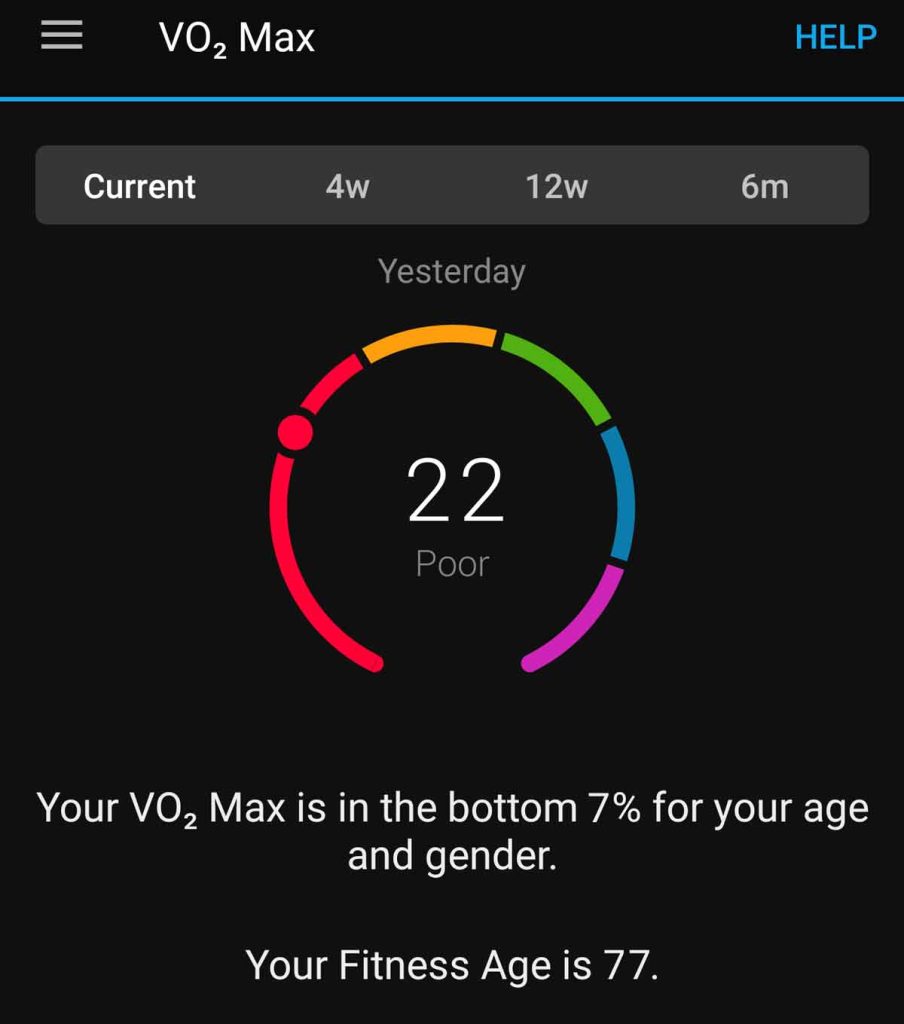
VO2 Max does not consider temperature, humidity, or even elevation. To expand, if your run route takes you up a hill, so you naturally slow down, you’re now less fit – HR vs. Pace.
Here are a few examples that you can see where VO2 max readings stay almost the same despite different training routines of varying degrees of intensity.
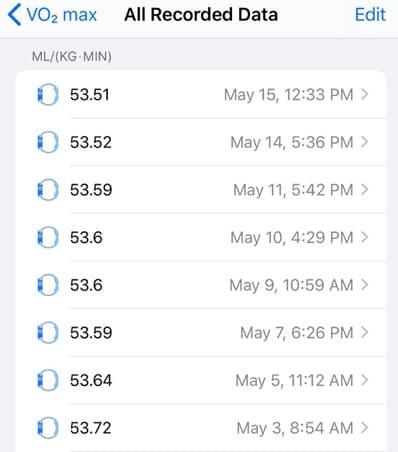
Here is another example of a user who has regularly worked out without noticing changes in recorded VO2 Max.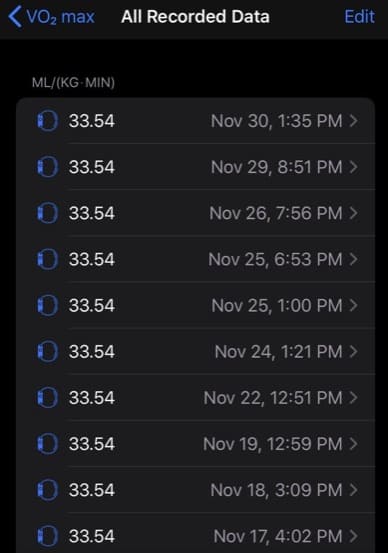
Here’s another example from a user who had not changed his exercise routine but noticed that the VO2 Max spiked.
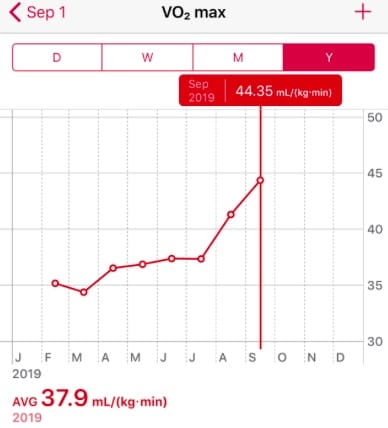
This is a small sample, and we are taking the user’s words towards our inferences, but it does show that there could be problems with how the VO2 estimation works on various fitness trackers.
You can also check and compare your VO2 max / Cardio fitness scores directly in the Apple Health app. Here’s how:
How to compare your V02 Max on Apple Watch for similar age and sex
Starting with watchOS 7.2, Apple made a few tweaks to the algorithm that calculates your V02 Max or cardio fitness levels.
One of the major changes introduced was allowing users to compare their VO2 Max (Cardio Fitness levels) with that of others in the same age group and sex.
This requires you to take a couple of additional steps when checking your cardio fitness levels on the Apple iPhone.
-
- Open the Health app on your iPhone and tap on ‘Browse’ at the bottom.

- Tap on Heart followed by Cardio Fitness.

- Select any cardio fitness score for a day by tapping on the data point on the graph.

- Next, tap on the score at the top of the screen.
- Tap on the ‘i’ icon.

- This shows you the V02 Max / Cardio Fitness scores by sex and age group.

- Open the Health app on your iPhone and tap on ‘Browse’ at the bottom.
How does Apple Watch determine a low or high Cardio Fitness score?
Apple uses the established FRIEND database to look up reference values by sex and age and compares it with the readings collected from your Apple Watch to determine low or high Cardio Fitness score.
The Fitness Registry and Importance of Exercise National Database (FRIEND) is a repository that holds reference values for VO2 Max / Cardio Fitness scores.
These are the first cardiorespiratory fitness reference data using measures obtained from CPX (cardiopulmonary exercise testing), the gold standard for VO2 Max in the United States.
FRIEND can be used to provide a more accurate interpretation of measured VO2 max from maximal exercise tests for the US population compared with previous standards based on workload-derived estimations.
How accurate is Apple Watch’s Cardio Fitness Score?
Cardio fitness on Apple Watch estimates a user’s VO2 max in ml/kg/min, based on measuring a user’s heart rate response to physical activity. Updates to the algorithm used to estimate VO2 max in watchOS 7 extend estimates to lower cardio fitness ranges (14 to 60 ml/kg/min) for users with Apple Watch Series 3 or later.
Apple’s design approach for its Cardio Fitness Score
Apple collected data for the design and validation of the VO2 max metric across multiple studies, approved by an institutional review board (IRB), involving participants who consented to collecting and using their data for this purpose.
Study participants completed VO2 max tests, VO2 sub max tests, or both — referred to as cardiopulmonary exercise testing, or CPET — while wearing Apple Watch Series 4. Various CPET test protocols were used, including both treadmill and cycle ergometers.
Each participant completed up to six CPETs throughout the studies, with at least ten days between consecutive tests to ensure participants had sufficient time to rest between tests and adequate periods for data collection before and after individual CPETs.
Tests that passed the verification steps were used in algorithm development. To obtain the reference VO2 max of each participant, linear projections were made using heart rate and VO2 in the sub-max range to determine VO2 max based on age-predicted maximum heart rate.
The predicted maximum heart rate was lowered for users on heartrate-limiting medications, such as beta-blockers.
Note: It’s important to add your heart medication details to Apple Health to receive the proper cardio fitness score. With the new algorithm, VO2 max estimates for users who take heart rate–limiting medications — such as beta-blockers and calcium channel blockers.
As shown above, Apple’s approach to validating the Cardio Fitness metric assured its accuracy in numerous studies.
In the case of the Apple Watch and other wearables, the base data for many calculations is your heart rate. Numerous studies have shown the accuracy of the Apple Watch’s heart rate.
As per Apple, VO2 max estimation by Apple Watch is accurate and reliable relative to commonly used methods of measuring VO2 max, with an average error of less than 1 MET and an ICC of more than 0.85. The accuracy of VO2 max on the Apple Watch approaches the accuracy of the reference.
According to Apple, increasing the number of outdoor pedestrian workouts will increase the likelihood and accuracy of a VO2 max estimate on the Apple Watch.
What causes inaccurate cardio fitness scores on Apple Watch?
Having said that, some factors influence the accuracy of cardio fitness scores, and Apple has highlighted these in its research paper. We highlight the most important ones for you below:
- The user has not updated personal details on the Apple Health app. If you enter an incorrect age, sex, or weight, you may consistently see inaccurate VO2 max estimates.
- Pregnancy can cause inaccurate estimates of VO2 max
- Cardio Fitness scores will be low, as per Apple, if sensor data is recorded during behaviors that increase the user’s workload in a way that Apple Watch can’t detect.
- Apple Watch may show you inaccurate readings if you run or walk on sand or any surface that increases your effort.
- You are running with a backpack carrying an extra load
- Factors that increase heart rates, such as dehydration, caffeine intake, extreme heat, or recent transition to high altitudes, may also lead to underestimates.
Note: Studies suggest that cardiovascular fitness index VO2max is associated with CIMT (Carotid intima-media thickness) in middle-aged men. VO2 max is an important indicator for the prevalence of carotid atherosclerosis.
Cardio Fitness Score not showing on Apple Watch
This seems to be one of the most researched questions from new Apple Watch users.
If you are not seeing the Cardio Fitness Score in the Health app, chances are that you may not have had a chance to review Apple’s guidance.
- According to Apple, Over 90 percent of participants with at least one outdoor walk, outdoor run, or hiking workout longer than three minutes and tracked using the Workout app received at least one estimate of VO2 max on Apple Watch.
- Cardio Fitness Scores are only available if you walk, run outdoors, or hike. Other workouts will not reflect the score.
- The 3 Minutes’ guidance is important. You will have to exercise at least for three minutes with good intensity to see a cardio fitness score.
2. Increasing the number of outdoor pedestrian workouts or runs will increase the likelihood and accuracy of a VO2 max estimate on the Apple Watch.
The 5.75 Minutes mystery for Apple Watch users
Although Apple’s guidance says three minutes of activity, their research also shows that the optimal number of exercise minutes to generate a VO2 max or Cardio Fitness score is 5.75 minutes.
93% Percentage of participants who completed at least 10 outdoor pedestrian workouts longer than 5.75 minutes and received at least one estimate in their first ten workouts
79% of outdoor pedestrian workouts longer than 5.75 minutes received an estimate.
Bottom line, if you just purchased an Apple Watch, you may have to work out for at least 10 regular outdoor runs/walks/hikes to increase the chances of seeing your accurate VO2 max score.
Other reasons why your VO2 Max is showing low could be because of the following key points:
Software updates on the fitness tracker
Most fitness trackers and smartwatches go through various software upgrades.
Sometimes, it is possible that the manufacturer adjusted the calculations, and you notice a drop in your VO2 Max.
Since there is little transparency around how they calculate the score, it is hard to determine. Your low VO2 max reading could result from the changes in calculations.
Wrong user profile information 
Your user profile (particularly weight, sex, and age information) plays a vital role in the calculations.
- Got a new or replacement Fitbit? How to set it up so you don’t lose data
- How To Update Body Measurements on Your Apple Watch and iPhone
If you see an unusual or abnormal VO2, Max, check your user profile information on your fitness tracker to ensure that you have entered the correct information.
Check the heart rate sensor on the back of the fitness tracker 
Is it scratched? Is it dirty?
These could impact the quality of your heart rate readings.
Since HR readings are based on the calculation of VO2 Max, your low or abnormal VO2 Max could be due to a malfunctioning heart rate sensor.
Check with your doctor and get a real VO2 Max test.
Should you be concerned about the low VO2 Max? For most folks, the answer is probably no.
If you see that your VO2 Max consistently stays below the average acceptable score ( 37.9 for men and 27.6 for women), you can reach out to your doctor and have them perform a real VO2 max test at their office.
Can you increase your VO2 max score on your Fitness tracker? 
Honestly, there is not much that you can do. Although many people claim that your VO2 Max is trainable, your genetics are the biggest determinant…and something you cannot change.
If you come into the lab and get tested with a VO2 max of 50 ml/kg/min, the best you can hope for with “all the training in the world” is an improvement to ~57 ml/kg/min. There’s only a 5-15% potential improvement (3). Not a whole lot of wiggle room there.
A study that looked at VO2 max values in twins (9) concluded that genetic factors explained 72-74% of the difference in VO2 Max and, even when “sports participation” was factored in, genetic factors continued to explain between 57% and 63% of the variance in VO2 Max.
Presumably, studies like this confirmed that VO2 Max was largely genetic and could only be increased by a small amount through training.
That being said, most users training for endurance runs or other high-intensity routines regularly see a 5 – 15% improvement in VO2 Max over time.
Logging into a 20-minute, high-intensity outdoor run workout weekly will help increase your VO2 Max. 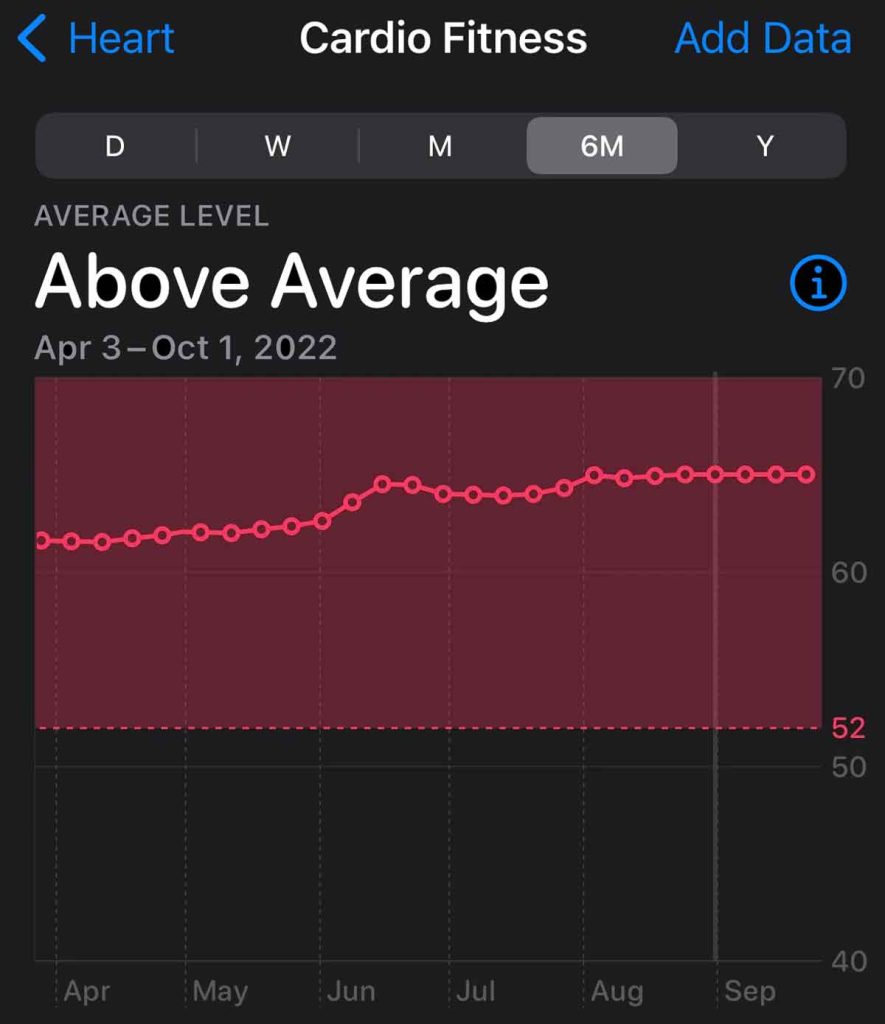
How does VO2 Max influence other related metrics?
When your VO2 Max goes up, your resting heart rate goes down.
Lower is better with Resting Heart Rate. A resting heart rate between 60 and 100 beats per minute is normal for most people.
It’s affected negatively by stress, hormones, and medication. Getting into better shape can not only lower your resting heart rate but it could also help save your life.
Those with a high VO2 Max will likely also have a lower resting heart rate, lower blood pressure, and lower risk for chronic diseases, as these are also positively correlated with being fit.
Exercising regularly using HIIT or an endurance run, you should improve your VO2 max score and overall health.
References
- https://well.blogs.nytimes.com/2010/07/19/a-carb-boost-without-the-carbs/
- https://www.mayoclinicproceedings.org/article/S0025-6196(15)00642-4/pdf
- https://simplifaster.com/articles/how-trainable-is-vo2-max/
- https://www8.garmin.com/manuals/webhelp/vivosmart4/EN-US/GUID-1FBCCD9E-19E1-4E4C-BD60-1793B5B97EB3.html
- https://www.garmin.com.sg/minisite/garmin-technology/health-science/heart-rate/
- https://support.apple.com/en-us/HT204666
- https://help.fitbit.com/articles/en_US/Help_article/1565.htm
- https://www.silabs.com/sensors/biometric/si1143-44
- Fagard, R., Bielen, E. and Amery, A. “Heritability of aerobic power and anaerobic energy generation during exercise.” Journal of Applied Physiology. 1991; 70(1): 357-362.

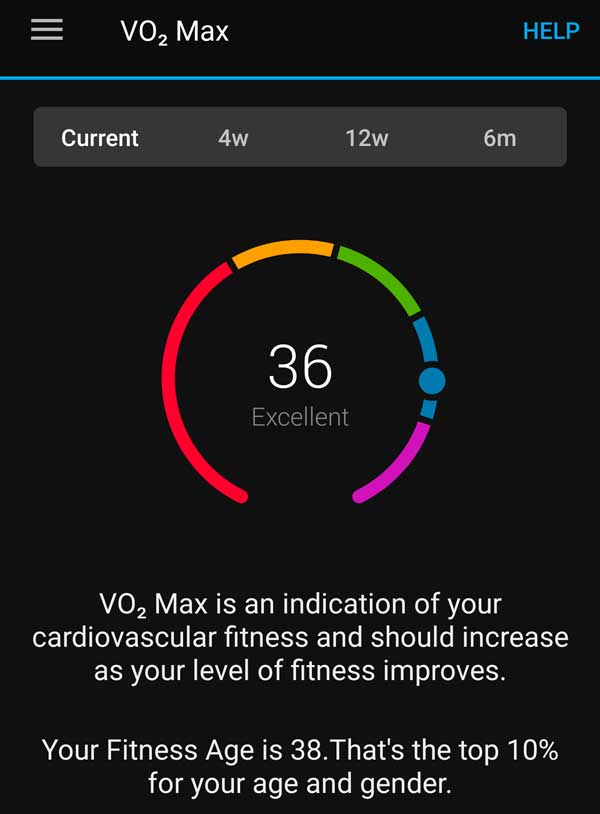
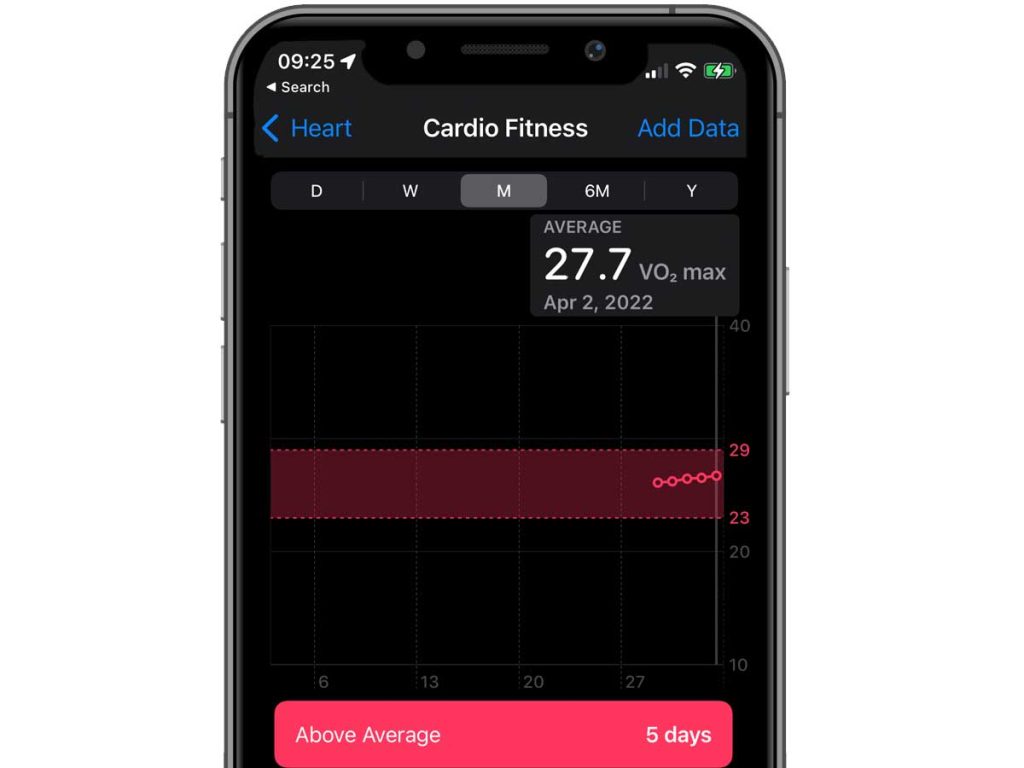

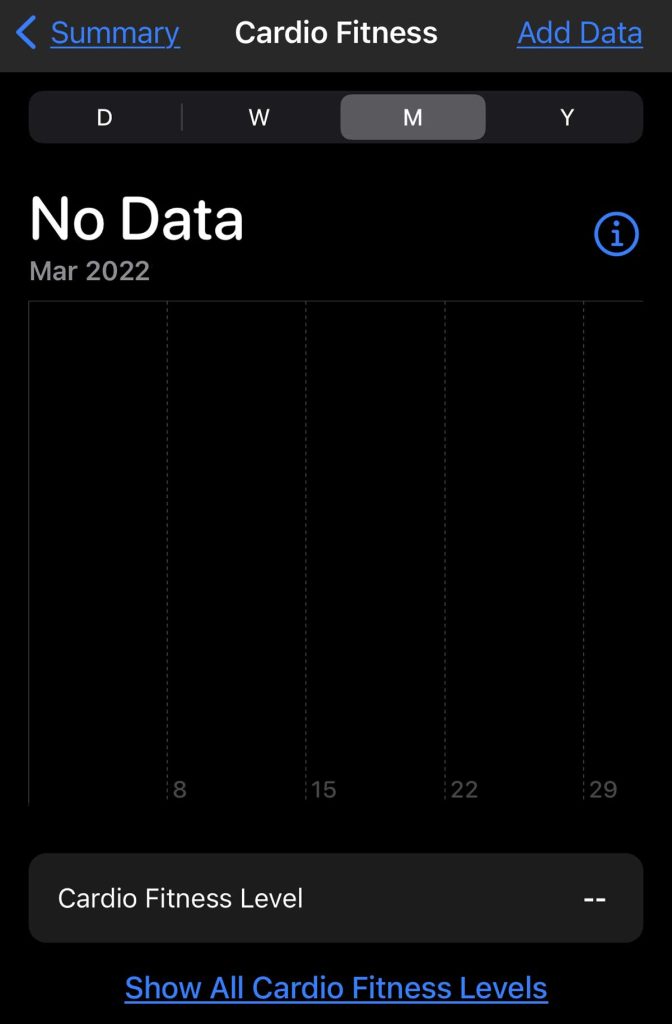
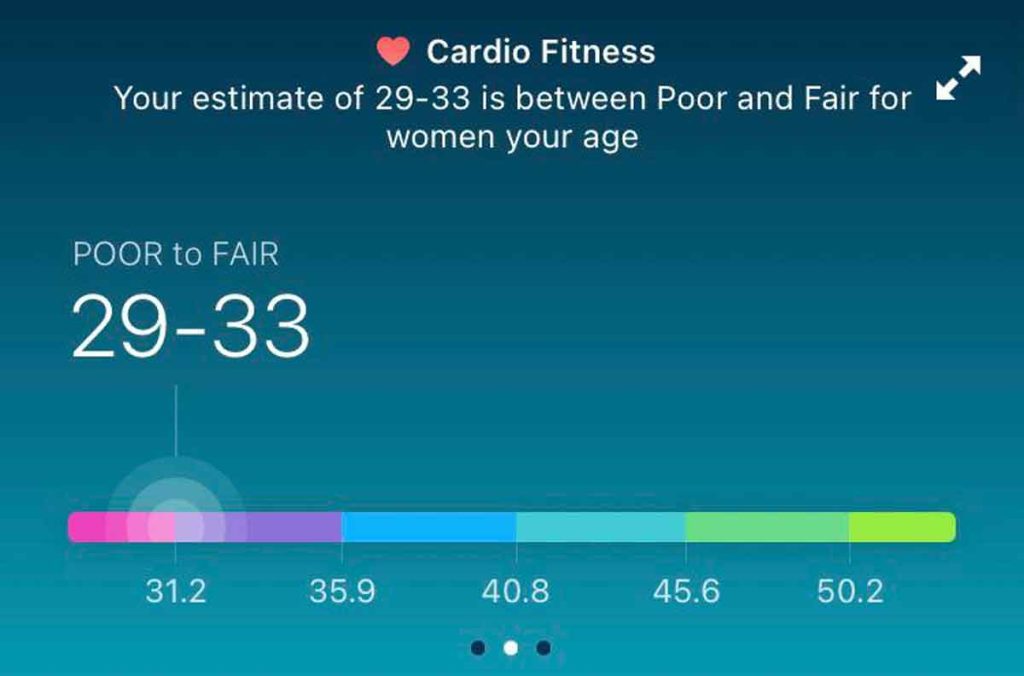
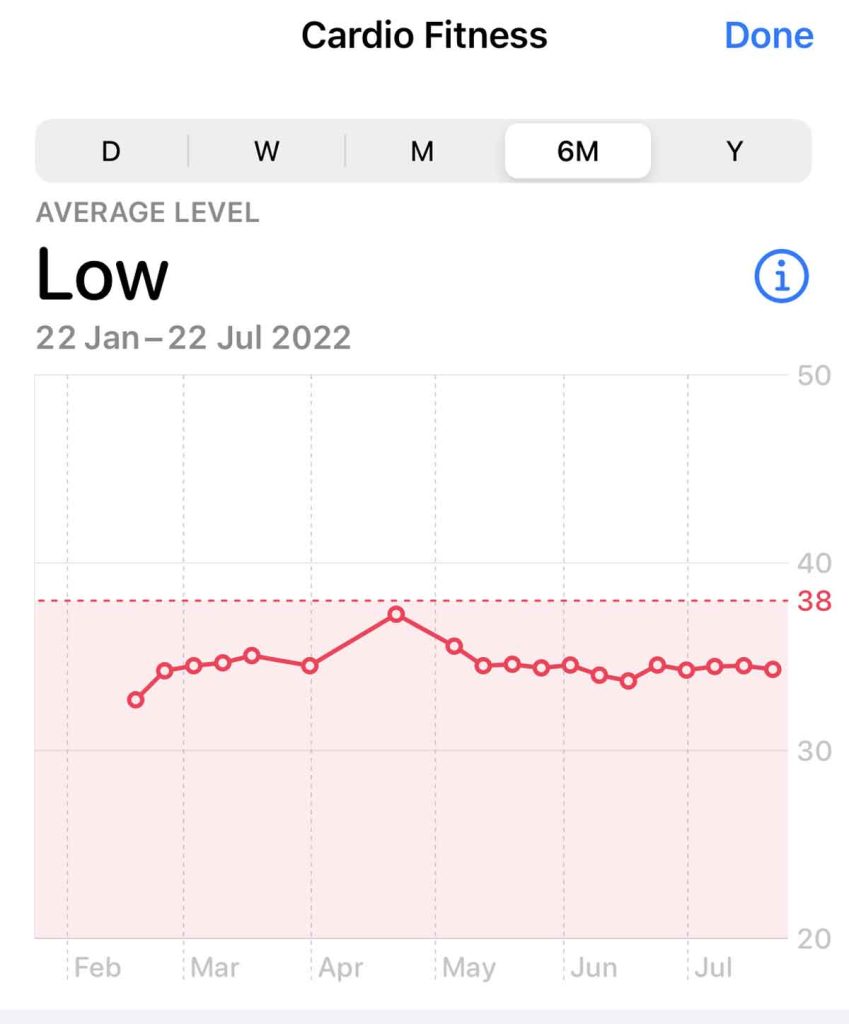
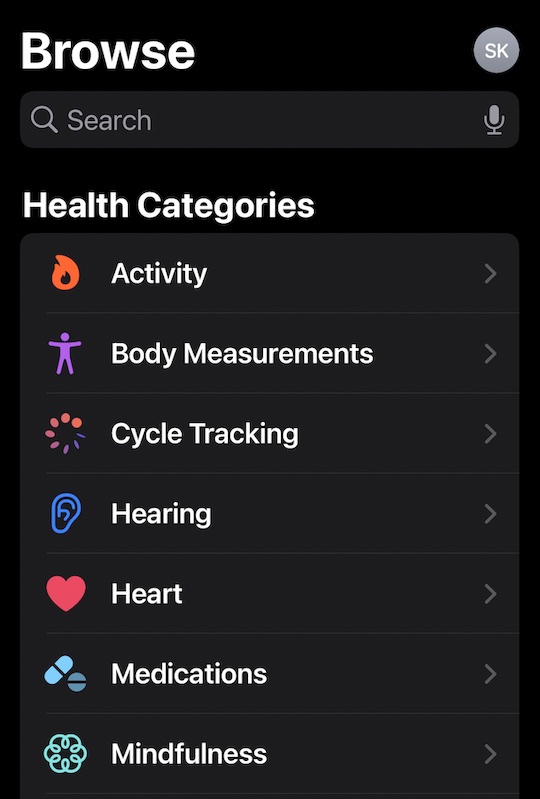
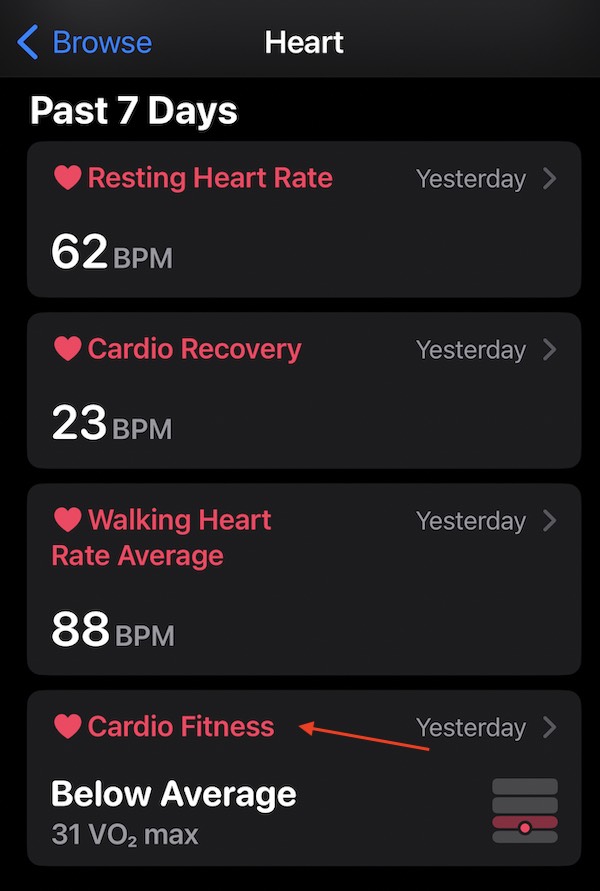
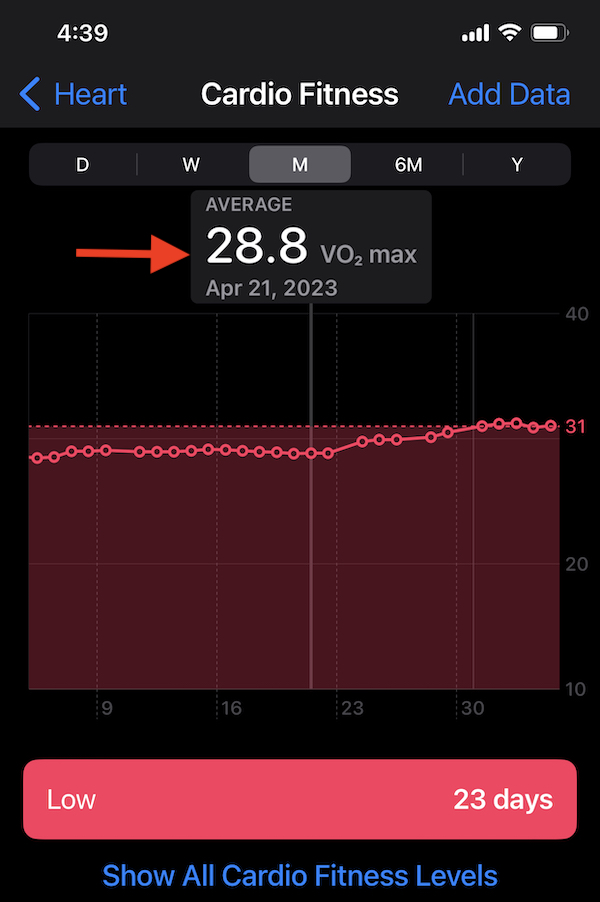
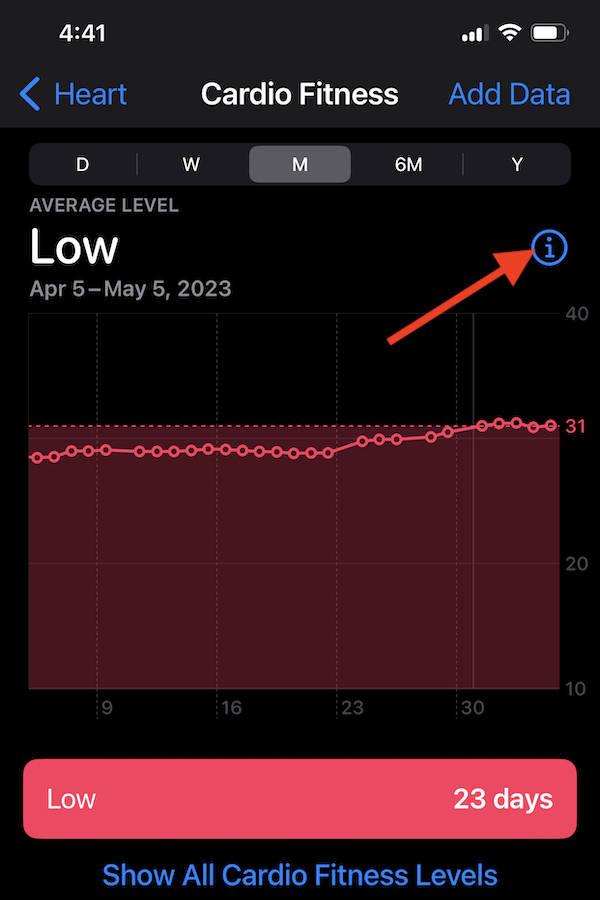
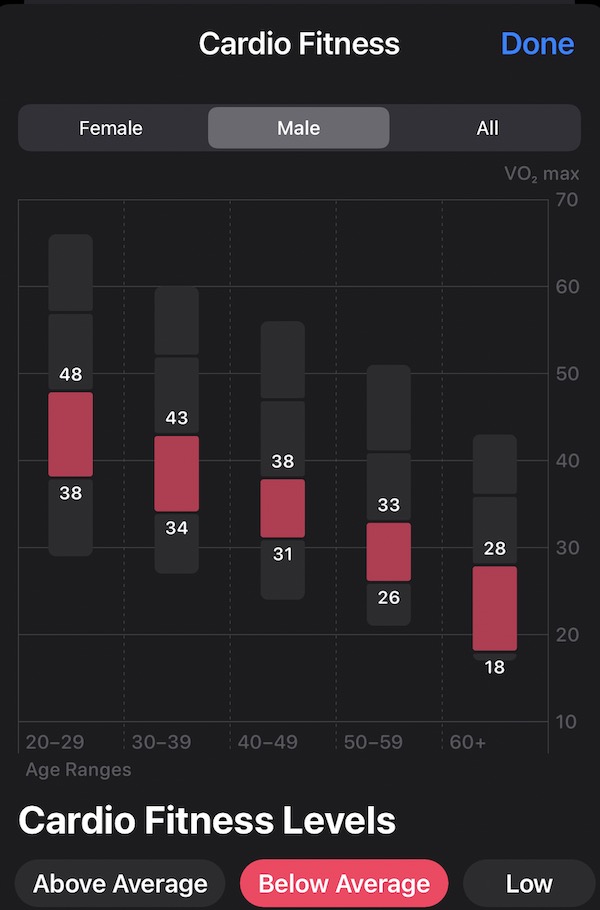
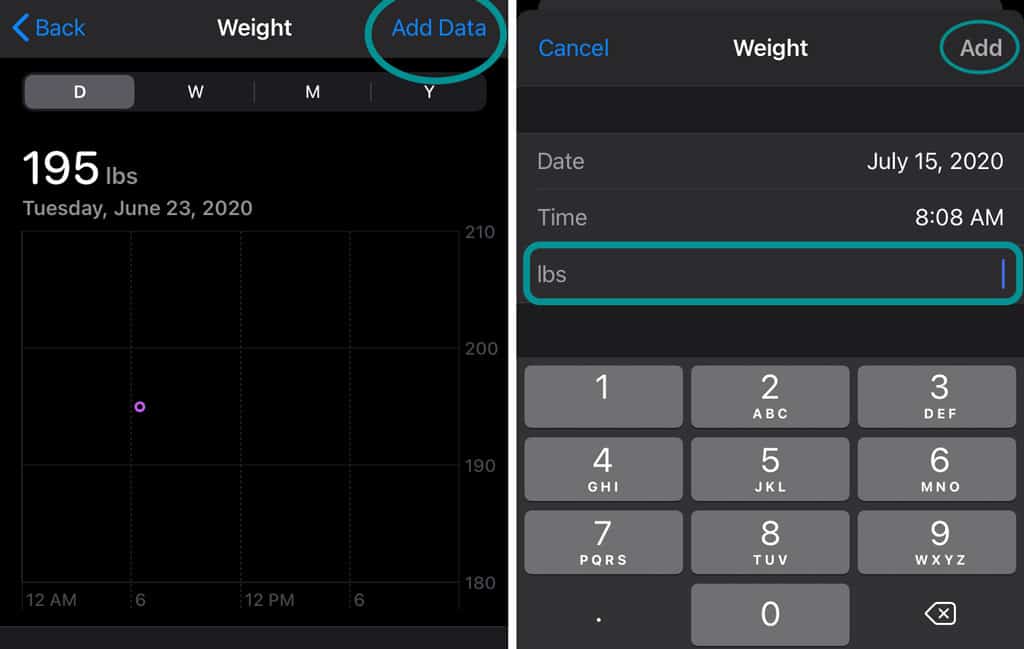

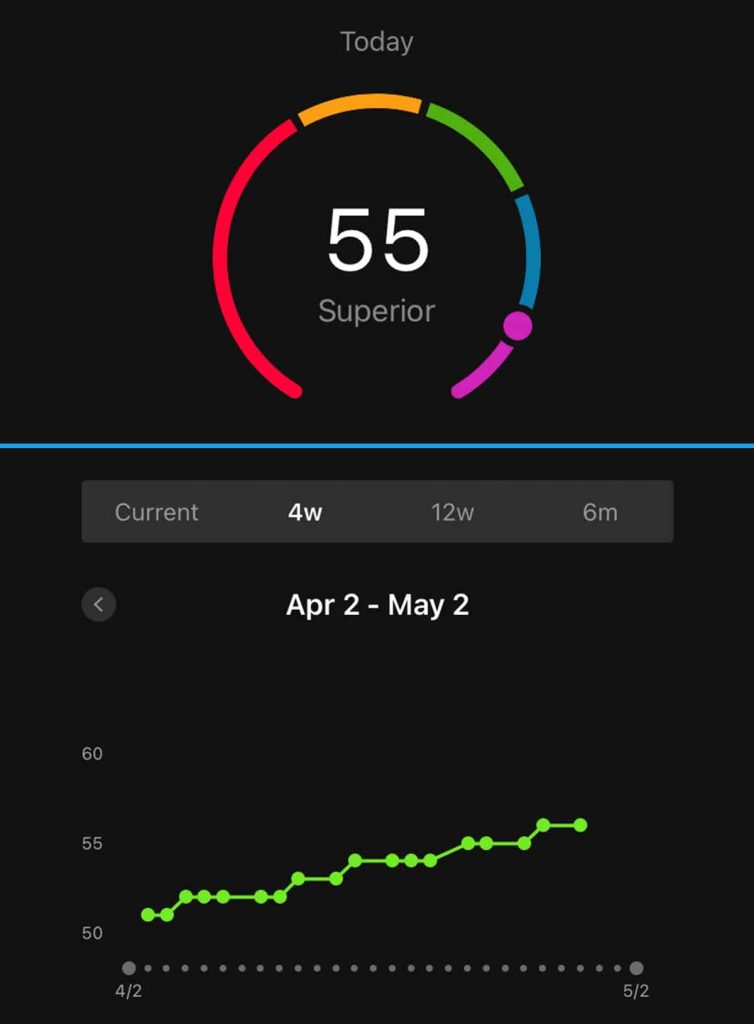
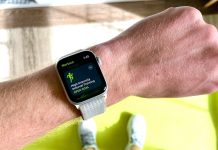





Thanks for this in-depth explanation.
I’m an avid cyclist on a bike, typically riding hills 4-5 days a week.
During my more intense sessions, I’ve seen my HR Max hit 188 this year, and the current resting HR is about 52, which puts my VO2 Max around 54 using the simple formula you provided (and I’m 54 years old).
My Apple Watch has been giving me much lower VO2 numbers (35-40) for years which had been troubling me a bit. I guess I can take the Apple number with a grain of salt at this point!
I’m not allowed to do HIIT after my MI (although i used to do Insanity twice a week). I get that these watches aren’t that accurate but given the equation you stated and everyone else seems to have scores >36 it does make me think if my watch is faulty?
Is the info in this article accurate? You state you can calculate VO2Max thus VO2 max = 15.3 x (MHR/RHR).
So mine would be 170.9/63 x 15.3 = 41.5!!!!! This would put me in the High Cardio fitness range for my age, which is bonkers.
Compared to my Apple Watch rating of just 20.3 which put me so low I imagine I shouldn’t even be able to walk up the stair without gasping!
So your calculation basically has one variable factor, and that is Resting Heart Rate. So even with a fairly rapid RHR of 90i would still achieve a VO2 of 29.5 which is just below average.
The simplest accepted formula to calculate VO2 max is called your heart rate measurement, which uses your resting heart rate, maximum heart rate, and age to determine your Vo2 max. That formula is usually 15.3 x (HRmax/HRrest) or 15 x (HRmax/HRrest.)
All of these formulas, including Apple’s, are rough estimates–and many people see wide variations of their scores based on how they calculate them. So your experience is not unusual. What’s actually more predictive is the VO2 Max trend–so instead of looking at the number, look if the trend is going higher or lower over time, like a month, 6 months, or a year.
When trending higher, your training is improving your body’s cardio fitness. When trending lower or staying the same, your training is not improving your cardio fitness–in that case, change or add some additional high and low-intensity cardio workouts to your training routine. Combine exercises like high-intensity training (HIIT) with lower-intensity like biking, swimming, rowing, and hiking.
If you want a more exact measurement, you’ll need to do a cardiopulmonary exercise test at your doctor’s office or exercise medicine lab.
I’m at a loss – my Apple Watch has my VO2Max at 20.3 ie very poor – yet yesterday i did a 6.5km walk in 60mins in 24c heat and average pace was 9m22s/km (4mph) My average heart rate was 112bpm across the walk with a peak of 119bpm and a low of 91. My recovery rate went from 119-90 in 1 minute and down to 82 in 2 minutes. When finished I had broken a mild sweat but nothing much. Also my resting heart rate is always between 59 and 66. I’m a 53 year old male (very overweight, true and had a heart attack 2 years ago).
My wife who is 49 and has a VO2Max of 26.8 could not keep up with me after the first KM and couldn’t get passed to 3.5km mark – her peak HR was also 119 (mine was 110bpm at the 3.5km mark).
I felt so good afterwards i went and did another 5km walk for the hell of it although at a slower ave pace of 9m44sec per Km
I realize I am not superfit or even fit but I don’t know many people, even some friends in their 40s who go to the gym who can maintain a <10m/km pace for an hour solid easily.
So I am trying to understand why my VO2Max is showing so very, very low. If it was showing Below Average would my heart rate only average at 104bpm or Average 96bpm on such a walk as the pace would be very hard to increase to beyond 4mph without breaking into a jog or falling over.
Before I moved to the States (and in my 20s) i used to run a lot , especially lots of 10kms with my all-time best time a respectable 43m.21sec. I don’t run anymore out of mental fear from the recent heart attack clearly that took a toll on my heart’s effectiveness although my Ejection Fraction measured 55% just 2 months after my heart attack.
So I am at a loss. If my VO2Max at a very low 20 is accurate I would expect that 20 should be the new Average given the sate of fitness levels.
@Martin, did the change happened around Dec 2018 onwards? i had the same issue and puzzled. Mine dropped from 47 to 34/30, was Excellent to Below Average within few months. Till today it hovers around 32-35. Suspect it’s a calculation change by Apple.
Hey Niel,
This is a really useful article, thanks so much. I have been using my Apple Watch to track my fitness and specifically VO2max. My VO2Max has gone up steadily over 8 months from 40.2 to 47.6 mid August. I am 58 years old male, so this appears excellent.
Now for the past 8 weeks my VO2max has declined steadily and sharply, down to 43.2. I realize this is still good and I feel quite fit but the trend is worrying.
Do you know of any reasons that could cause such a steady decline? Lungs, heart? The sensor is clean and unscratched.
Best, Martin
Hi Martin,
Congrats on those excellent VO2 Max scores!
There are a lot of things that can impact your score, such as an illness, overtraining, and changing sleep or exercise routines. And remember that at this time Appel calculates this score using your outdoor walk, run, or hike workouts–it does not take into account any other workouts, although they also contribute to your overall cardio fitness. So, if you changed some of your workouts to cycling or another cardio workout, it could impact your VO2 Max score.
Also, if you updated your iPhone and/or Apple Watch during that time, there could be an algorithm change that changes how Apple interprets VO2 Max scoring–updates often do this and it simply means that our devices and the machine intelligence that powers them are getting more refined in how they interpret our data. So, although your score is a bit lower, it may be a more accurate picture.
If you suspect an update is to blame for the sudden change, wait it out and see if your scores steadily improve with time.
Thanks for the article, which is really interesting.
I’m prompted to look for information on this as my VO2 (measured on an Apple Watch) seems stubbornly stuck.
I’m doing a fair amount of indoor cycle training using Zwift at the moment – is this an activity that Apple Watch uses to track and update VO2 max?
BTW The University of Kansas link is no longer working – would it be possible to update with the new link?
Hi Chris,
At this time, your Apple Watch measures cardio fitness only during these activity types: outdoor walk, run, or hike. So cycling indoors or outdoors does not yet count towards your cardio fitness score on Apple devices (VO2 Max.)
Thanks for the heads up on the U. of Kansas fitness tool–they changed the location of that–it’s now here (and we updated the article too.)
Niel Smith,
On a scale of 1 to 10.0, this article rates a 10.0!
Thanks for sharing information at this level of detail!
I use the Apple Watch 6. Was on a beta-blocker blood pressure med(Bystolic 10 mg) which dropped my resting pulse rate to the low 40’s during the nite.
It also dropped during the day. Got off the beta-blocker and my daily 7-mile hike my pulse rate jumped 85 to 100. Needless to say, my VO 2 max went lower.